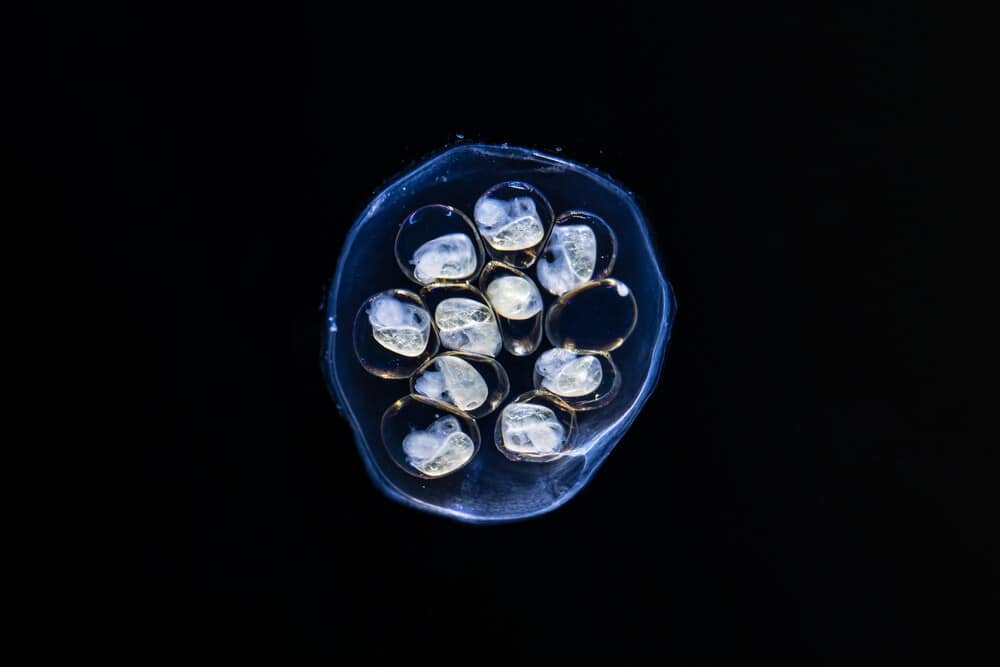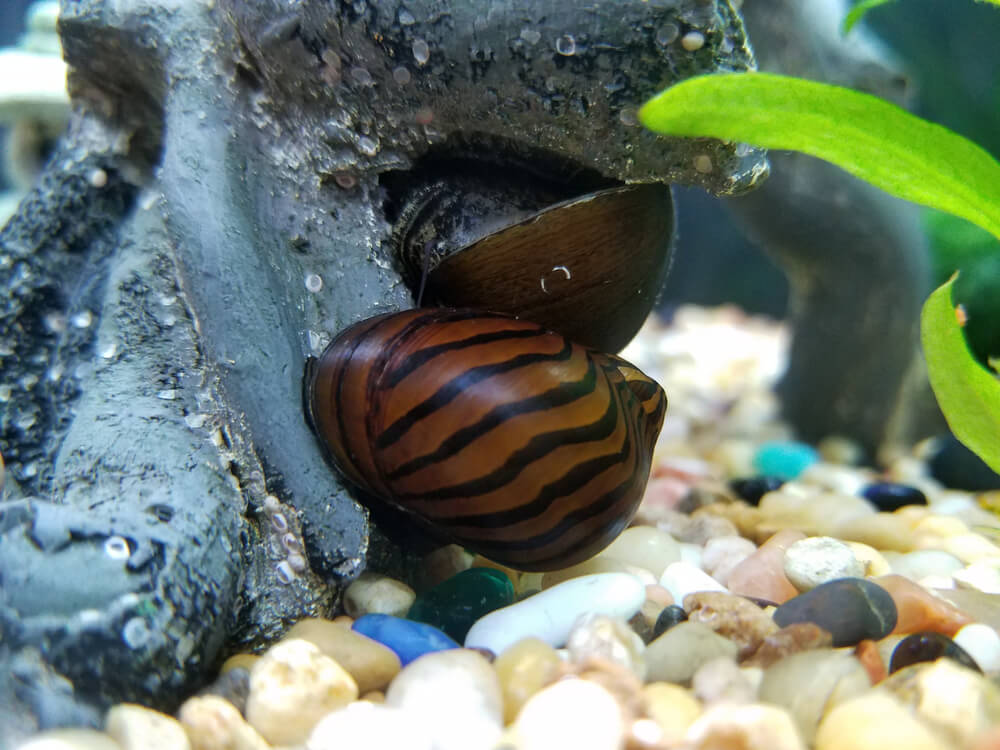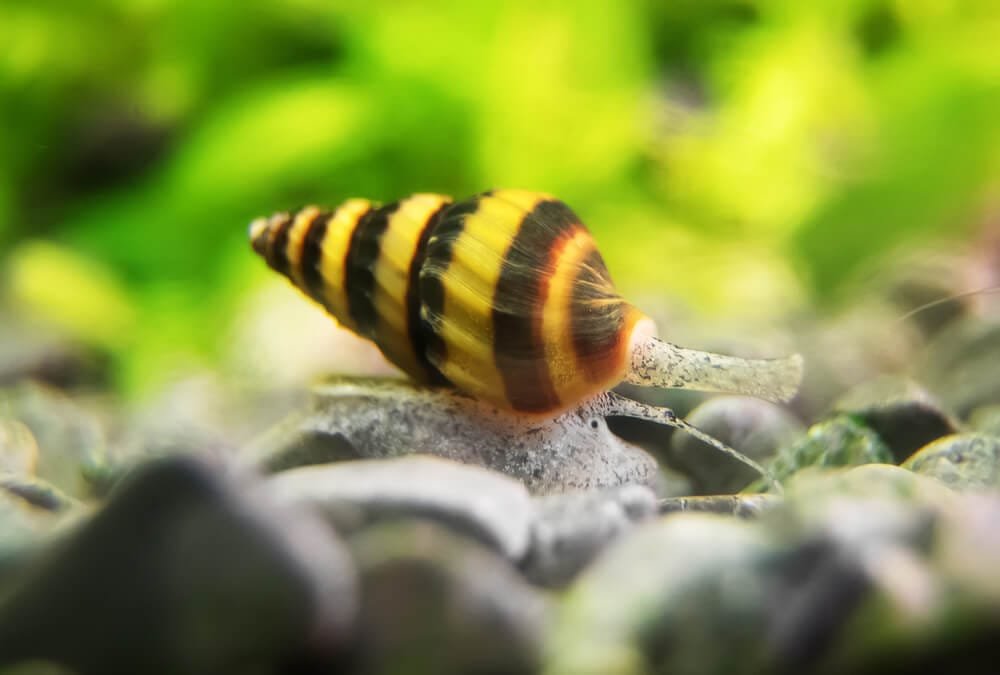Aquarists have a love-hate relationship with snail eggs in tank. For some aquarium hobbyists, these mollusks are an excellent addition to a thriving fish tank community, helping keep the water clean for everyone else in the tank. Others consider snails nothing more than a nuisance.
Deciding whether to keep snails and let them lay eggs in the aquarium can be daunting for beginner aquarists.
We’re here to help you make a well-informed decision, including the proper care you’ll need to give to your snails and their eggs if you decide to keep them. Let’s start.
An Overview Of Aquarium Snail Eggs
Snail eggs in tank are often a sign of a thriving aquarium ecosystem if you believe these mollusks are an essential part of your fish tank setup. Unfortunately, most aquarists see these eggs as a sign of infestation and something they must get rid of immediately.
One issue with aquarium snails is they reproduce pretty quickly, potentially overpopulating your aquarium within a few weeks.
Snail eggs can get into your fish tank without you knowing it. For example, the aquatic plants or aquarium ornaments you bought had snail eggs. That’s why it’s best to quarantine these items for two weeks before adding them to the tank.
The issue is not always the size. Snails have a talent for hiding their eggs, just like any safety-minded parent would for their offspring. Hence, snails can lay eggs in leaf folds and crevices and undersides of driftwood.
Still, a few snail species don’t lay eggs at all. They give birth to live offspring, like the Japanese trapdoor snail.
Most aquarium snails are prolific, while a few species are somewhat tame. Ramshorn snails and Bladder snails breed often and can lay hundreds of eggs at a time. On the other hand, Rabbit snails and Assassin snails might reproduce only once monthly.
Appearance
You might think these eggs are easy to spot. Unfortunately, they’re not. A single snail egg can be about 1/75 of an inch, while a snail clutch (a cluster of snail eggs) can be a quarter of an inch.
Snail eggs can have a milky pink color or a vibrant blue hue, although most are whitish or cream-colored. Some snail eggs have a translucent form, complete with a jelly-like texture.
Benefits Of Snail Eggs (and Snails) In Aquariums
Snail eggs make an excellent food source for some fish species. For example, goldfish, loaches, gouramis, and catfish have a knack for feasting on snails and eggs.
They can get their bone health-giving calcium and growth-promoting protein from snail eggs, ensuring your fish thrive and live a happy life.
Another reason why snail eggs in aquariums are a good idea is you’re producing future tank cleaners. Snails gobble up algae, fish waste, uneaten fish food, plant debris, and other substances in the water, keeping your aquarium looking pristine and safe for your fish.
Some snails also make excellent snail control. For example, Assassin snails (as the name implies) kill other snail snails, especially the highly prolific ones. You can rely on these snails to keep mollusk populations in check.
If you’re looking to improve your aquarium’s aesthetics, adding a few cool-looking snails should spice your fish tank. And what better way to start the process than with snail eggs of your chosen species.
Drawbacks Of Having Snail Eggs (and Snails) In Your Fish Tank
The principal concern about having snail eggs in tank is infestation resulting from uncontrolled snail population growth. Complicating the issue is the snails’ skill in hiding their eggs.
The snail eggs are also quite challenging to spot unless you actively search for them in crevices, under the leaves, on rocks, and almost any object and surface in your fish tank.
Although snails are excellent tank cleaners, they can also produce waste adding to the fish waste.
The problem becomes more serious if you have an uncontrolled snail population growth. What makes the cycle more vicious is snails gobble up organic matter, making them more prolific.

How Aquarium Snails Reproduce
Aquarium snails are marvelous aquatic creatures deserving our attention and respect. You can decide whether to keep the snail eggs or not by understanding how aquarium snails reproduce.
Reproduction Speed
Some snail species are fast breeders, laying snail eggs a few times a week. The principal issue with such snails is their tendency to overpopulate and cause snail infestation in the aquarium.
Examples of these quick-reproducing snails are Pond snails, Ramshorn snails, Malaysian trumpet snails, and Bladder snails.
On the other hand, slow-breeders lay eggs only once monthly or every six to eight weeks. Some might not even ever breed, making them the ideal tank mates for fish and aquatic plants in an aquarium.
Excellent examples of these snail species are Nerite snails, Assassin snails, Rabbit snails, Brotia Pagodula snails, Black Devil snails, and Japanese Trapdoor snails.
Reproduction Method
You’d be surprised to learn that aquarium snails reproduce in different ways. Some species don’t need a mate to produce fertilized eggs, while others do. Other snails also have male and female reproductive parts, making them independent in making eggs.
Parthenogenetic or asexual snails don’t need a mate to produce eggs. You might think they’re hermaphrodites, but they’re not. These snails give birth to clones without male fertilization (a classic example is the Malaysian trumpet snail).
Hermaphroditic snails have male and female reproductive parts, allowing them to fertilize (the male component) the eggs (the female aspect) without requiring another snail. Examples of hermaphroditic snails include Ramshorn snails, Bladder snails, and Pond snails.
The last group of snails requires a mate to reproduce. Examples of sexually-reproducing snails are the Nerite snails, Japanese Trapdoor snails, Assassin snails, Rabbit snails, Brotia Pagodula snails, and Mystery snails.
These snails release the eggs within one to three months, while the snail eggs need one to five weeks to hatch.
Reproduction Form
Although we are talking about snail eggs, it’s crucial to understand that not all snails lay eggs. Malaysian Trumpet snails and Japanese Trapdoor snails are livebearers, giving birth to live offspring instead of producing eggs.
We call these species viviparous snails, differentiating them from oviparous (egg-laying) snails. Let’s summarize what we’ve learned so far.
It would be more challenging to control snail population growth if the snails in your tank:
- Don’t need a mate to reproduce (asexual or hermaphrodites)
- Reproduces several times monthly
- Lay eggs
The best species to put into your fish tank:
- Require a mate to reproduce (sexual)
- Breed infrequently to never
- Give birth to live snails
The Ideal Habitat And Care For Your Aquarium Snails
Raising your snail eggs in tank is one of the most exciting things you can do as an aquarist. You can think of them as your future tank cleaners. Allow them to hatch and watch them grow to mature snails, and you’ll have trusty assistants to keep your tank in tiptop shape, including its other inhabitants.
However, there are several things you must observe to make the most out of your snail eggs.
Tank Setup
Snails and eggs don’t need plenty of space to grow, especially if you can promise to control their population. A five-gallon tank will suffice. It would be best to have driftwood, rocks, and live aquatic plants for your snail eggs to attach to, hatch, and grow in.
Once your snail eggs hatch, you’ll need a standard filter to help control ammonia and nitrate levels. Baby snails cannot ‘eat’ and process these substances yet. That’s why they need help.
Water Parameters
If you want to hatch your snail eggs, you’ll want a warmer water temperature. The recommended temperature for snail breeding and hatching is 65 to 80 degrees Fahrenheit or 18.3 to 26.7 degrees Celsius.
On the other hand, lowering the water temperature will limit the number of eggs aquarium snails produce. Unfortunately, some fish species don’t do well in a cold environment.
Alkaline water is also more suitable for snail breeding and hatching, allowing you to find joy in watching baby snails break free from the eggs faster.
Acidifying the water is necessary if you want to control the snail population. Too bad your other aquarium inhabitants might suffer.
If you’re raising Nerite snail eggs, the water parameters can be tricky.
These snails require brackish water to hatch. Hence, you must transfer your Nerite snail eggs into a separate fish tank, including whatever object they’re attached to.
Nerite snail eggs must hatch into an environment that mimics their natural habitat in the wild. You must recreate this natural ecosystem if you want your Nerite snail eggs to hatch and the baby snails to survive.
Besides these water parameters, aquarium snail eggs also thrive best in a fish tank with a water pH between 7.0 and 7.5 and a hardness level of 5 to 15 dKH.
Tank Mates
Choosing the ideal tank mates for your future aquarium snails depends on how you view them – as cleaners or as a food source.
If you want your freshwater snails to become a readily available food for your fish, it would be best to put gouramis, pufferfish, Bettas, loaches, goldfish, catfish, and Bala sharks in your aquarium.
These fish species will love munching on the calcium-rich, high-protein snail eggs and adult snails.
On the other hand, it would be best to steer clear of snail-eating fish predators if you wish to hatch your snail eggs to become tank cleaners. Your best bets, in this case, are Tetras, Rasboras, and Danios.
Diet
Aquarium snail eggs don’t require feeding because they live off the gelatinous sac covering them. However, it’s best not to overfeed your fish because uneaten fish food can give snails more nutrition to procreate, producing more snail eggs.
It’s also best to regularly remove the algae in your fish tank and prune live aquatic plants to lower detritus. These techniques can reduce snail egg production.
Population Control
Although aquarium snail eggs can provide your fish with a protein-rich food source and efficient cleaners for the tank, they can grow in numbers without notice.
Population control is a must if you don’t want snails to overrun your fish tank. Here are several tips.
- Quarantine all new aquarium elements – live aquatic plants and ornaments – for 14 days before placing them in the fish tank.
- Dip live aquatic plants in a solution made of water and salt, hydrogen peroxide, or bleach to kill snail eggs before placement in the aquarium.
- Add snail-eating predatory fish, like Bettas, pufferfish, loaches, catfish, gouramis, and goldfish to the aquarium.
- Reduce your snails’ food sources by regularly cleaning the tank, removing algae, pruning aquatic plants, eliminating dead leaves, and changing the water frequently.
- Don’t’ overfeed your fish, and try to reduce their feeding portions.
- Manually remove the snail eggs, checking all possible hideouts.
- Consider adding copper-containing medications to the aquarium to kill snail eggs and snails. Unfortunately, your fish might suffer from this method. Use it with extreme caution and only as a last resort.

A Look At Some Of The Most Common Snail Eggs You’ll Find In Your Fish Tank
You must learn the following snail eggs if you’ve reached this far and believe having snails in your fish tank makes perfect sense.
Nerite Snail Eggs
You’ll see these eggs on aquarium heaters, ornaments, decorations, glass, and HOB filter intakes. Nerite snail eggs are unmistakable because they are white and create a stunning contrast to a dark background.
Unfortunately, these snail eggs stubbornly adhere to surfaces, requiring vigorous scraping if you want to take them off.
Nerite eggs thrive in brackish water, making these snails ideal for aquarists who dislike overcrowding their fish tanks with Nerite snails. If you must hatch the eggs, it’s best to transfer them to a different holding tank until they grow.
Nerite snails reproduce sexually, giving you the chance to prevent them from mating and producing eggs.
Mystery Snail Eggs
These snail eggs are a bit unusual for their color and form. Mystery snail eggs are elongated and narrow with a beautiful soft pink hue. You can see them above the waterline, making them vulnerable to drying out if not properly hydrated.
Each Mystery snail clutch can contain 50 to 200 eggs, hatching in two to three weeks. However, it’s crucial to keep the clutches moist, not wet.
Like Nerite snails, Mystery snails (also called Apple snails) need a partner to reproduce. They make perfect inhabitants of aquariums with a single-sex snail population.
Assassin Snail Eggs
Assassin snails aren’t as prolific as other species, producing a single egg with each reproduction. However, you might see other single yellowish eggs nearby (about five millimeters apart and forming a straight line) that turn brownish after two to three days.
Assassin snail eggs have rectangular translucent sacs that adhere to lava rocks, driftwood, glass, and other firm surfaces. The snail eggs need six to eight weeks to hatch, with the baby Assassins burying themselves into the sand to maturity.
Assassin snails also reproduce sexually, like Mystery and Nerite snails.
Ramshorn Snail Eggs
Unlike Assassin snail eggs occurring in single-egg clusters, Ramshorn snail eggs have a dozen in each brownish globule. These tiny orbs are translucent, allowing you to see the snail embryos developing in the eggs.
You’ll see these eggs on aquatic plants and aquarium walls, while newborn Ramshorns are near-transparent, bordering on white.
Rabbit Snail Eggs
Rabbit snails are unique because they release a pencil eraser-sized egg sack but don’t contain a snail embryo. Instead, the creamy-white egg sack has a fully formed and very hungry baby Rabbit snail. Hence, it’s tempting to classify Rabbit snails as viviparous (livebearer) instead of oviparous (egg-laying).
These snail eggs love to attach to the aquarium’s hard surfaces, hatching as live baby Rabbit snails in three to four hours.
The Japanese Trapdoor and Malaysian Trumpet snails are also worth putting in your fish tank since they give birth to live offspring, not lay eggs.
Frequently Asked Questions
What Do You Do With Snail Eggs In A Fish Tank?
If you’re a fan of snails, the best thing you can do with the eggs is to leave them alone.
Their sac does more than protect them from the aquatic environment. It also nourishes the individual snails, making for a hands-off embryonic development and hatching.
You can also let the snail eggs hatch into tiny snails, providing your pufferfish with a calcium-rich, high-protein diet.
Snails make excellent food sources for gouramis, zebra loaches, yoyo loaches, Betta fish, clown loaches, Bala sharks, cory catfish, and dwarf chain loaches.
Maintaining your fish stock’s optimum nutrition is hassle-free if you leave the snail eggs to hatch and grow.
The last option is to dispose of the snail eggs before hatching and overrunning your fish tank. Snails are prolific reproducers, allowing them to overpopulate an area in record time.
Too many snails in your aquarium can increase nitrate and ammonia levels and make the water less hospitable to fish and other tank inhabitants.
Do Snail Eggs Need To Be Fertilized?
Snail eggs can be fertilized or unfertilized depending on the species. For example, female Nerite snails must mate with males to fertilize their eggs. On the other hand, Mystery snails can still lay fertilized eggs without a mate.
Female Mystery snails can keep viable sperm cells in their systems for 140 days, allowing the mollusk to lay fertilized eggs weekly. You can expect the snail to produce unfertilized eggs if it remains mateless for the next four and a half months.
It’s easy to tell if a snail egg is fertilized or not. You can check for tiny brownish to black specks in the egg clutch. You have fertilized snail eggs if you see the dots; unfertilized if not.
Can Snail Eggs Dry Out?
Yes, some snail species can have their eggs dry out.
For instance, Apple snails, Mystery snails, and snails that produce and store eggs above the waterline are vulnerable to drying out. These snail species require adequate hydration for their eggs.
Because they are above the waterline, these snail eggs have an increased risk of drying out.
Draft and heat can draw out the moisture from the snail clutch, leading to dehydration. Unfortunately, the snail eggs become unviable once dried out.
How Often Do Aquarium Snails Reproduce?
Aquarium snails can reproduce or lay eggs at least once monthly, producing five to two hundred snail eggs per clutch. Some species give birth to live offsprings, such as the Japanese trapdoor snails. It’s not uncommon for aquarium snails to be more productive, especially in ideal fish tank conditions.
What Does Aquarium Snail Eggs Look Like?
Aquarium snail eggs vary in appearance depending on the species. It would be best to learn your snail specie’s life cycle to understand what its eggs look like.
You’re most likely looking at snail eggs in your fish tank if you see tiny grape-like clusters on the waterline, aquarium walls, under the leaves, driftwood, rocks, decorations, and other surfaces.
Although some freshwater snails lay individual eggs, most of them produce several at a time. Snails enclose their eggs in a gelatinous sac that protects and nourishes the developing embryos.
Some snail eggs have a pinkish or vibrant blue hue, while most have a cream-colored or whitish color. You might also see tiny translucent, clustered pearls in your fish tank with an uncanny jelly-like texture.
You’ll know you have fertilized snail eggs if you see tiny brown or black specks in the ova. Over a few days, you’ll notice the eggs’ hue darken a little. It’s a sure sign snail embryos are developing and growing.
If you don’t see specks in the eggs, or they don’t change in color over time, you have unfertilized snail eggs.

Conclusion
You can leave snail eggs in tank to hatch, grow, and mature if you want a readily available food source for some of your fish or need a future dependable tank cleaner.
They can also make an excellent addition to your aquarium, creating a unique ecosystem worth watching. Otherwise, you can always ditch the snail eggs when you see them in your fish tank.
You already have everything you need to make an intelligent decision, including the pros and cons of having snail eggs and snails in your aquarium and how to care for them.
Start with the slow-reproducing, viviparous, and sexually-reproducing snail species and make your aquatics adventures more worthwhile. You can expand later if you’ve mastered the tricks.







